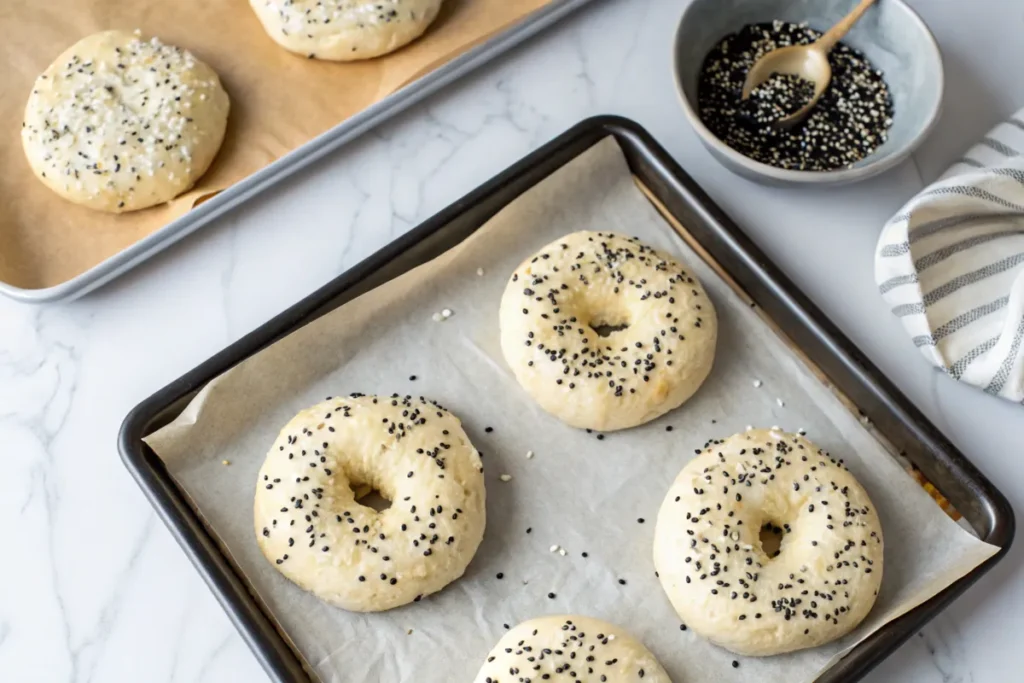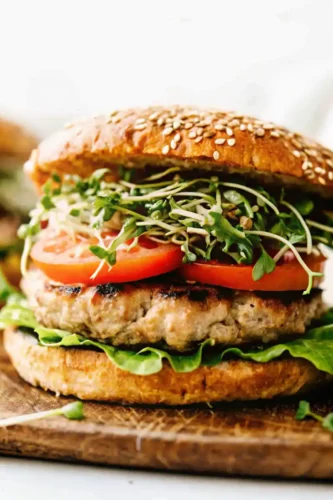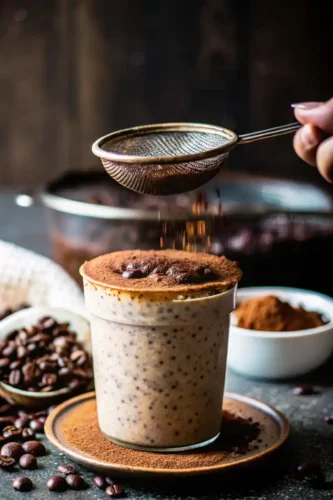Making sourdough discard bagels is a satisfying adventure for both beginners and seasoned bakers. This article walks you through everything: what sourdough discard is, why it’s perfect for bagels, and exactly how to craft these chewy, golden rounds of joy. From tools and ingredients to creative toppings and troubleshooting tips, we’ve got you covered. Fill your kitchen with the comforting aroma of freshly baked bagels and discover the magic of sourdough.
Table of Contents
Why Everyone Loves Sourdough Discard Bagels?
Bagels have always been a breakfast favorite, but the idea of using sourdough discard to make them has brought a new wave of creativity to kitchens everywhere. Sourdough discard, the portion of starter removed during feeding, is packed with flavor and offers a tangy depth that traditional bagels lack. It’s a sustainable way to reduce waste while creating a treat you’ll love.
Making bagels at home allows you to control every ingredient, ensuring you enjoy a healthier alternative to store-bought versions. By using sourdough discard, you enhance the bagels’ nutritional profile through natural fermentation, which is known to improve digestion and nutrient absorption.
Homemade bagels also mean endless customization. Whether you prefer the classic everything seasoning or enjoy experimenting with sweeter variations like cinnamon raisin, the possibilities are limitless. Plus, the fermentation process in sourdough improves texture, creating a chewy bagel interior and a perfectly crisp crust.
So, why settle for bland, processed bagels when you can bake fresh, nutritious sourdough bagels right in your kitchen? All you need is a little sourdough discard and some baking enthusiasm!
Let’s Talk About Sourdough Discard
What Is Sourdough Discard?
Sourdough discard refers to the portion of sourdough starter that is removed during the feeding process. A sourdough starter is a mixture of flour and water teeming with wild yeast and beneficial bacteria, creating a natural fermentation process. When the starter is “fed” with fresh flour and water, some of the old mixture is discarded to maintain balance and prevent overgrowth.
But here’s the good news—this so-called “waste” is anything but useless! Sourdough discard is still packed with flavor and has the same tangy, slightly acidic qualities as the active starter. It lacks the full leavening power needed for bread but works perfectly in recipes like pancakes, crackers, and, of course, bagels. The unique taste and fermented goodness of discard make it an excellent addition to your baking repertoire.
Why Use It for Bagels?
Using sourdough discard in bagels not only infuses them with a tangy, rich flavor but also contributes to the perfect chewy texture. The fermentation process breaks down starches, making the dough easier to handle and bake. Bagels made with sourdough discard have a depth of flavor that’s simply unmatched by those made with commercial yeast.
Beyond flavor, sourdough discard is a hero for sustainability. Instead of tossing out part of your starter during feedings, you can transform it into delicious creations, reducing food waste in the process. This small act of reuse contributes to an eco-friendly kitchen, which aligns with the growing trend of sustainable living.
Additionally, making bagels with discard allows for more creativity in the kitchen. Whether you’re a seasoned baker or just starting out, incorporating discard into recipes is an easy way to experiment and hone your skills. Not to mention, it’s a conversation starter when you serve these artisan-style bagels to friends and family!
Your Bagel Adventure Begins
Ingredients You’ll Need
To make the perfect sourdough discard bagels, start with a handful of simple, high-quality ingredients. Here’s your shopping list:
- Bread Flour: A high-protein bread flour is key for that classic chewy bagel texture. All-purpose flour works in a pinch but won’t deliver the same results.
- Sourdough Discard: Make sure your discard is fresh (stored for no more than a week in the fridge). This will give the bagels their tangy flavor and fermentation magic.
- Sugar or Honey: A touch of sweetness balances the tang and helps with caramelization during baking.
- Salt: Essential for flavor—don’t skip this!
- Water: Lukewarm water is ideal for mixing and activating the dough.
- Optional Toppings: Everything bagel seasoning, sesame seeds, or poppy seeds add a finishing touch.
Tools to Make the Process Easy
Baking sourdough discard bagels is much easier when you have the right tools. Here’s what you’ll need:
- Mixing Bowls: One large bowl for the dough and smaller ones for toppings.
- Kitchen Scale: For precise measurements, which are crucial in baking.
- Stand Mixer (Optional): If you have one, it makes kneading a breeze. No mixer? No worries! Hand-kneading works just as well.
- Dough Scraper: Handy for shaping the dough and cleaning your work surface.
- Baking Sheet with Parchment Paper: Ensures even baking and prevents sticking.
- Large Pot: For boiling bagels before baking—this step is essential for their texture.
- Slotted Spoon: Perfect for removing boiled bagels from the water without losing their shape.
Alternatives abound, so don’t fret if you’re missing a tool. For example, a regular spoon can substitute for a slotted one, and a regular knife can handle dough dividing. Precision and care matter more than fancy equipment!
Having these essentials on hand will set you up for success, turning your kitchen into a bagel-making haven. With just a little preparation, you’ll soon enjoy fresh, homemade bagels that rival any bakery.
Step-by-Step Recipe for Sourdough Discard Bagels
Mixing the Dough
To start your sourdough discard bagel journey, combine these ingredients in a large mixing bowl: 500 grams of bread flour, 200 grams of sourdough discard, 10 grams of salt, 20 grams of sugar or honey, and 250 milliliters of lukewarm water. If you’re using a stand mixer, attach the dough hook and knead for 8-10 minutes until the dough is smooth and elastic. Prefer a hands-on approach? Knead by hand for about 12 minutes on a floured surface.
Here’s a tip: resist the urge to overmix. The dough should feel tacky but not sticky. Overmixing can lead to dense bagels, which we definitely want to avoid! Cover the bowl with a damp cloth and let the dough rest for 4-6 hours at room temperature, or until it doubles in size. This step allows the sourdough discard to work its fermentation magic, giving the bagels their signature flavor and texture.
Shaping Like a Pro
Once the dough has risen, turn it out onto a floured surface and divide it into 8 equal portions. To shape each bagel, roll a portion into a smooth ball. Then, using your thumb, gently poke a hole in the center and stretch it to about 2 inches wide. The hole will shrink slightly during boiling and baking, so don’t be afraid to make it a bit larger than expected.
Beginner hack: If you’re struggling with consistency, try using a small round cookie cutter to make uniform circles before poking the hole. Or, roll the dough into a log and join the ends to form a ring.
Place the shaped bagels on a parchment-lined baking sheet, cover with a clean kitchen towel, and let them rest for 30-45 minutes. This short proofing period allows the gluten to relax, making the bagels easier to boil and bake.
Shaping bagels is an art form, but don’t sweat it! Imperfect bagels have their own charm, and the flavor will speak for itself.
The Boil-and-Bake Magic
Boiling is the secret step that gives sourdough discard bagels their chewy texture and glossy exterior. In a large pot, bring water to a boil and add a tablespoon of sugar or honey—this enhances the bagels’ caramelization during baking.
Using a slotted spoon, carefully lower a few bagels into the boiling water. Boil each side for 30 seconds to a minute. For a chewier texture, extend the boiling time slightly. Once boiled, place the bagels back on the parchment-lined baking sheet.

Preheat your oven to 220°C (430°F) while the bagels dry slightly. Brush the tops with an egg wash or a splash of milk for a golden finish. Sprinkle your favorite toppings, like sesame seeds, poppy seeds, or everything seasoning.
Bake for 20-25 minutes, or until the bagels are golden brown and sound hollow when tapped. Let them cool on a wire rack before serving.
This boil-and-bake method ensures a crisp crust and chewy interior, turning your homemade bagels into bakery-worthy delights.
Time to Get Creative
Toppings and Flavors to Try
Toppings are the final touch that takes your sourdough discard bagels from great to extraordinary. The classic choice? Everything bagel seasoning. This savory blend of sesame seeds, poppy seeds, dried garlic, onion flakes, and salt offers a perfect crunch and burst of flavor. Prefer something simpler? Stick with sesame or sunflower seeds for a nutty note.
For sweet lovers, cinnamon sugar or a drizzle of honey pairs beautifully with the tangy sourdough flavor. Feeling adventurous? Create your own combinations, like za’atar spice mix or shredded parmesan for a savory twist.
Homemade spreads elevate your bagels to gourmet status. Whip up garlic butter, herb cream cheese, or even a sweet mascarpone spread with a touch of honey and lemon zest. DIY toppings let you control the ingredients, ensuring both freshness and flavor.
Variations for Every Mood
One of the best parts of making your own bagels is the freedom to experiment. Love a hint of sweetness? Add raisins and a sprinkle of cinnamon to the dough for classic cinnamon raisin bagels. Craving something bold? Jalapeño cheddar bagels deliver a spicy, savory kick with melted cheese oozing into every bite.
For a healthier twist, try whole grain bagels by substituting part of the bread flour with whole wheat or rye flour. These variations not only add distinct flavors but also increase fiber and nutrient content.
Seasonal ingredients can inspire endless creations, from pumpkin spice bagels in autumn to fresh blueberry bagels in the summer. When you make bagels at home, the possibilities are as limitless as your imagination.
Serving and Storing Your Bagels
Freshly baked bagels are best enjoyed the same day, but proper storage keeps them tasting great for longer. To store, let the bagels cool completely and place them in an airtight container at room temperature for up to two days. For longer storage, freeze bagels individually wrapped in plastic wrap, then place them in a resealable freezer bag. They’ll stay fresh for up to three months—just thaw and toast before serving.
Bagels aren’t just for breakfast! Transform them into hearty sandwiches with fillings like smoked salmon, cream cheese, and capers. Use mini bagels for bite-sized sliders at your next party, or go bold and turn leftover bagels into bagel pizzas topped with marinara, mozzarella, and your favorite toppings.
Creative serving ideas make sourdough discard bagels versatile for any meal. Whether it’s a casual snack or a gourmet brunch centerpiece, these bagels are guaranteed to impress.
Troubleshooting & FAQs
Bagel Problems? Let’s Fix Them!
Even with the best intentions, making sourdough discard bagels can come with a few hiccups. But don’t worry—most problems are easy to fix!
Flat bagels? This usually happens if the dough is over-proofed. When bagels rise for too long, the gluten structure weakens, causing them to spread out instead of puffing up. Keep proofing time within 45 minutes to 1 hour for best results.
Dense bagels? If your bagels feel more like bricks, the dough might have been under-kneaded. Kneading develops gluten, which creates the bagels’ chewy texture. Use a stand mixer or your hands to work the dough until it’s smooth and elastic.
Bagels stick to the parchment paper? A quick fix: lightly grease the parchment paper or sprinkle it with cornmeal before placing your shaped bagels.
Too chewy or tough? Overboiling can be the culprit. Stick to 30-60 seconds per side in boiling water for the perfect balance of chewiness.
Bagel-making takes practice, so embrace any imperfections. After all, even “flawed” bagels taste amazing!
FAQs About Sourdough Discard Bagels
Are sourdough bagels healthier than regular bagels?
Yes, sourdough bagels are often considered healthier due to the fermentation process, which improves digestion and increases the bioavailability of nutrients.
Is eating sourdough discard healthy?
Absolutely! Sourdough discard retains many of the beneficial bacteria from the starter. While it’s not as active as a fully fed starter, it still contributes to the nutritional value of baked goods, offering prebiotic benefits that support a healthy gut microbiome Read more
Why are my sourdough bagels so chewy?
Chewiness is a hallmark of bagels, but if they’re too tough, it could be due to over-kneading or overboiling. Keep kneading to about 10 minutes, and boil bagels for no more than 1 minute per side.
Can I freeze sourdough bagels?
Yes! Freezing bagels is a great way to preserve freshness. Let them cool completely, wrap individually in plastic wrap, and store in a freezer-safe bag. To enjoy later, thaw at room temperature or pop them directly into the toaster or oven. They’ll taste almost as fresh as the day they were baked!
Wrapping It Up
The Joy of Homemade Bagels
Making your own sourdough discard bagels is more than just a baking project—it’s a celebration of creativity, sustainability, and flavor. The process of transforming simple ingredients into golden, chewy perfection is deeply rewarding, not to mention delicious. Whether you stick with classic toppings or explore bold variations like cinnamon raisin or jalapeño cheddar, every batch is an opportunity to make something uniquely yours.
Experimentation is the key to finding your signature bagel recipe. Don’t be afraid to tweak the ingredients, proofing time, or toppings to suit your taste. Even small changes can yield delightful surprises. Plus, every homemade bagel is a small victory in reducing food waste by making good use of your sourdough discard—a win for your kitchen and the planet!
Once you’ve baked your bagels, why not share the joy? Snap a picture, share your results on social media, and inspire others to join the sourdough adventure. Tag friends, family, or even baking communities, and encourage them to try their hand at these artisan-style bagels.
The best part? Baking sourdough discard bagels is a skill that keeps on giving. Each time you bake, you’ll refine your technique, explore new flavors, and discover just how fun and versatile sourdough can be. So preheat that oven, grab your sourdough discard, and let the bagel magic begin!






